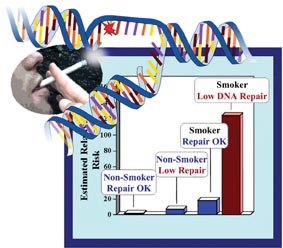
Clockwise from bottom left: Dr. Meir Krupsky, Dalia Elinger, Dr. Edna Schechtman, Dr. Tamar Paz-Elizur, Dr. Sara Blumenstein, and Prof. Zvi Livneh. Calculated risks
Lung cancer is one of the most deadly malignancies, responsible for 30 percent of all cancer deaths. Most sufferers from the disease – about 90 percent – are smokers. Weizmann research has now yielded a new blood test that can detect smokers who are at especially high risk of developing the cancer.
Our DNA is damaged about 20,000 times a day by such factors as sunlight, smoke and reactions within the body. If left unrepaired, damaged DNA can lead to cancer. Fortunately, the body has a stock of enzymes whose function is to repair DNA. Upon detecting the damage, the enzymes “operate” on the DNA, replacing the damaged parts with new ones. The efficiency of these repair enzymes is thus critical for preventing cancer.
After years of research into DNA repair systems, Prof. Zvi Livneh and Dr. Tamar Paz-Elizur of the Biological Chemistry Department decided to concentrate on a specific DNA repair enzyme called OGG1 (8-oxoguanine DNA glycosylase 1). This repair enzyme deletes DNA parts damaged by toxic molecules (called oxygen radicals) found in tobacco smoke. By developing a new blood test that enables them to measure the level of OGG1 activity, the researchers found that 40 percent of lung cancer patients have low levels of OGG1 activity. This, in contrast to only 4 percent of the general population. “Only 10 percent of heavy smokers develop lung cancer,” says Livneh, “and that suggested to us the involvement of a personal genetic susceptibility.” In collaboration with Dr. Meir Krupsky of the Chaim Sheba Medical Center in Tel Hashomer, the scientists tested this theory in lung cancer patients.

Risk for lung cancer according to Livneh’s research
The findings, published in the Journal of the National Cancer Institute, show that smokers who carry a genetic marker signifying low OGG1 activity are around 5-10 times more likely to get lung cancer than smokers whose OGG1 activity is normal – and 120 times more likely than non-smokers who have normal OGG1 activity. (Smoking increases the risk, since it results in more damage to the DNA, and thus more work for the repair enzymes.)
Screening smokers for low OGG1 activity will help them make more informed decisions about smoking. Of course, even smokers with normal OGG1 activity are at greater risk of getting lung cancer than the general population, and the blood test will not ensure that they don’t get the disease. In addition, smoking causes other types of cancer and cardiovascular diseases, whose relation to OGG1 activity is still unknown.
The Weizmann team also included Dr. Sara Blumenstein and Dalia Elinger. Statistical analysis was conducted by Dr. Edna Schechtman from Ben-Gurion University of the Negev.
Prof. Livneh’s research was supported by the M.D. Moross Institute for Cancer Research; the Dolfi and Lola Ebner Center for Biomedical Research; the Levine Institute of Applied Science; and the Josef Cohn Minerva center for Biomembrane Research. He is the incumbent ot the Maxwell Ellis Professorial Chair in biomedical Research.
Lung Cancer Stats
According to the American Lung Association:
- Lung cancer is the leading cancer killer in both men and women.
- There were an estimated 164,100 new cases of lung cancer and an estimated 156,900 deaths from lung cancer in the United States in 2000.
- In most cases, the disease might have been prevented - nearly 90 percent of lung cancer cases are caused by smoking.
- Secondhand smoking is responsible for approximately 3,000 lung cancer deaths and as many as 62,000 deaths from heart disease annually.
- When a person quits smoking, the risk of lung cancer decreases each year. Ten years later, the risk drops to one-third to one-half the risk for smokers.
- In addition, quitting smoking greatly reduces the risk of developing other smoking-related maladies, such as heart disease, stroke, emphysema and chronic bronchitis.
- Radon is considered the second leading cause of lung cancer in the U.S. today, with 12 percent of all lung cancer deaths linked to radon. The EPA estimates that nearly one out of every 15 homes in the U.S. has indoor radon levels at or above the level at which homeowners should take action - 4 picocuries per liter of air (pCi/L) on a yearly average. Exposure to radon in combination with cigarette smoking greatly increases the risk of lung cancer.
